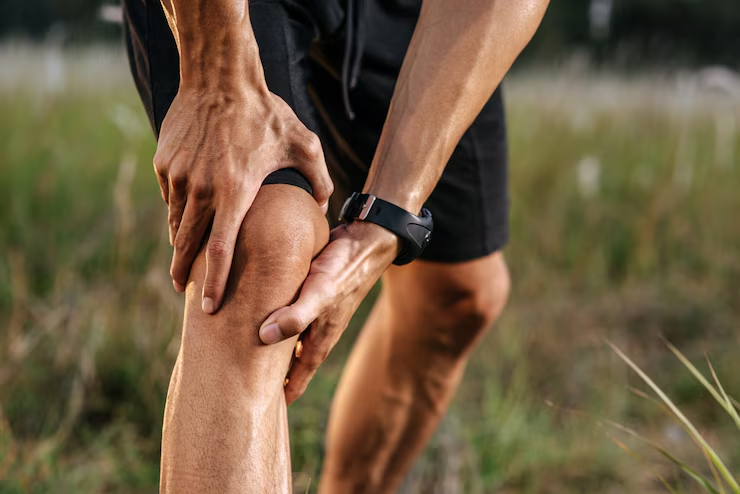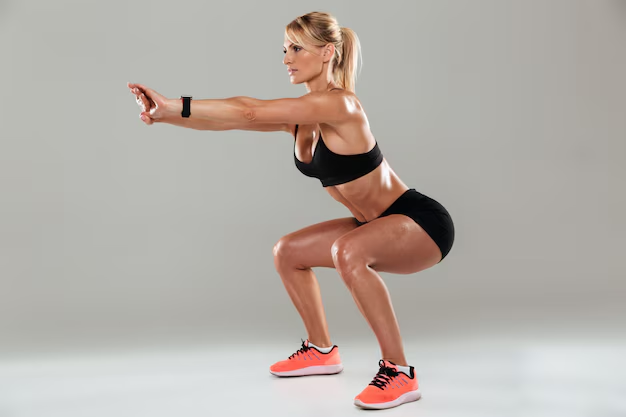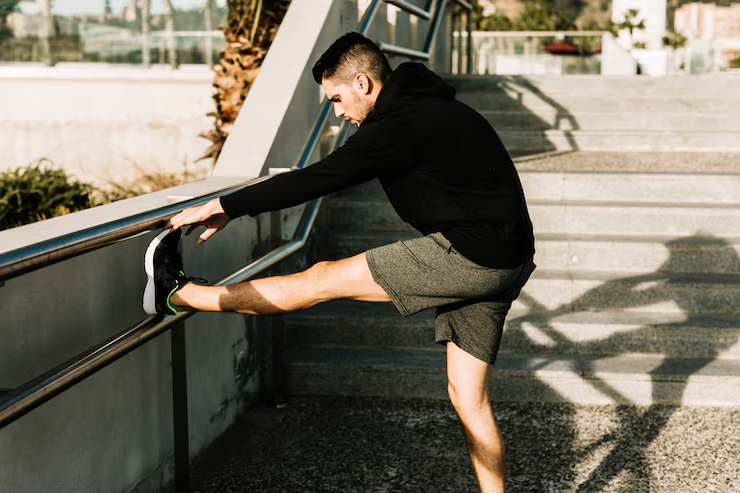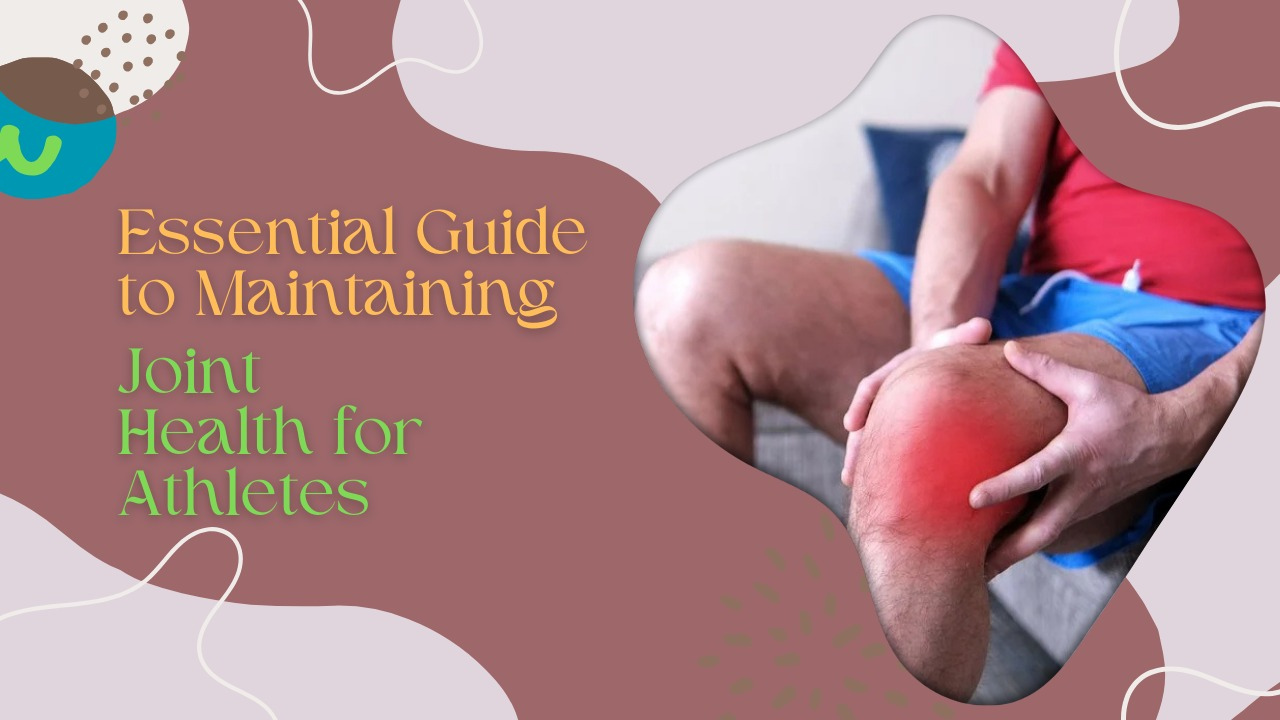For athletes of all levels, joint health is foundational to performance and long-term physical well-being. Whether you’re training for a professional competition or staying fit as a recreational athlete, maintaining healthy joints plays a crucial role in preventing injuries, maximizing mobility, and enhancing performance. Joints are essential for movement, allowing athletes to push their limits in running, jumping, lifting, and performing sports-specific techniques. Without healthy joints, performance suffers, and the risk of injury increases significantly.
In this comprehensive guide, we’ll explore how athletes can maintain and improve joint health by focusing on key areas like flexibility, strength, nutrition, recovery, and injury prevention strategies. From the young athlete looking to prevent future joint problems to the older athlete aiming to preserve mobility and strength, these principles are universally applicable. Understanding joint health and its maintenance strategies will empower you to continue performing at your best, regardless of your sport or age.
The Importance of Joint Health in Athletics

Joints are the complex structures that connect bones and enable movement. Healthy joints are essential for athletes because they directly affect performance, injury prevention, and overall physical well-being. Here’s why joint health should be a priority:
Injury Prevention: Healthy joints are better able to withstand the physical stress that comes with intense activities, lowering the risk of common sports injuries like sprains, strains, and tears. For instance, building proper muscle strength around the knee joint can significantly reduce the chances of injuries such as ACL tears. Similarly, maintaining stability in the shoulder joint can prevent painful and potentially career-ending issues like rotator cuff injuries. Proper joint health ensures that the body can handle the demands of sports with a lower risk of injury.
Enhanced Mobility: The flexibility and strength of your joints are crucial for a full range of motion, allowing athletes to perform sport-specific movements more effectively. Whether you’re sprinting, swimming, or participating in gymnastics, maintaining joint mobility and flexibility directly impacts overall performance. Joints that are well-maintained help with smoother and more efficient movement, which can make a substantial difference in an athlete’s ability to reach their peak performance level.
Longevity: Keeping your joints healthy over the long term ensures that athletes can continue to engage in their chosen activities for many years to come. By preventing excessive wear and tear, managing strain, and avoiding joint overuse, athletes can extend their careers and enjoy physical activities as they grow older. Joint health becomes especially important as you age, as it helps preserve mobility and reduces the likelihood of joint degeneration, ensuring a more active and fulfilling life.
Reduced Pain: Joint discomfort, whether it arises from overuse or conditions like arthritis, can be both physically and mentally exhausting. By maintaining healthy joints, athletes can minimize pain and ensure injuries heal more efficiently. Healthy joints can also reduce the likelihood of long-term complications, like chronic pain or permanent damage. When joints are in good condition, athletes can recover more effectively and get back to their routines without being hindered by ongoing discomfort.
Thus, joint health isn’t just about avoiding injury but also about maintaining peak performance and quality of life throughout an athlete’s career and beyond.
Key Strategies for Maintaining Joint Health
- Include Strength Training
Strength training is a powerful method for supporting joint health. By focusing on building muscle strength around the joints, athletes can reduce the stress placed directly on the joints. This helps protect against injuries like sprains and strains by stabilizing the joints and improving overall support.

Additionally, strength training enhances movement efficiency. Stronger muscles enable smoother and more controlled motions, which can lead to improved athletic performance. Not only does this reduce the risk of injury, but it also contributes to better overall joint function, allowing athletes to perform at their peak while maintaining joint health.
Strength Training Tips:
Focus on Compound Movements: Exercises like squats, lunges, deadlifts, and overhead presses target large muscle groups while also promoting joint stability. These movements engage multiple joints, making them highly effective for overall joint health.
Balance Muscle Groups: Ensure that you are strengthening both the primary and stabilizing muscles around each joint. For instance, when working the lower body, target the quadriceps, hamstrings, glutes, and calves. Similarly, for the upper body, focus on the shoulders, chest, and back, alongside smaller stabilizing muscles like the rotator cuff.
Vary Your Exercises: A well-rounded strength training program incorporates different movements to target the muscles from various angles. This reduces the risk of imbalances and ensures that all supporting muscles around a joint are strengthened.
Examples of Joint-Specific Strength Training Exercises:
Knee Health: Perform leg presses, lunges, and step-ups to build strength in the quadriceps, hamstrings, and calves. These muscles help stabilize the knee joint, reducing the risk of injury.
Hip Health: Squats, deadlifts, and hip thrusts strengthen the hip muscles and glutes, which protect the hip joint during high-impact activities.
Shoulder Health: Overhead presses, lateral raises, and external rotations strengthen the shoulder’s stabilizing muscles, such as the rotator cuff, reducing the risk of shoulder dislocations or tears.
- Focus on Flexibility and Mobility

Flexibility and mobility are essential for maintaining healthy joints. These factors allow the joints to move smoothly through their full range of motion, supporting proper movement patterns. Without sufficient flexibility, the joints may become restricted, making it harder to perform everyday tasks or athletic movements effectively.
When muscles are tight and joints are stiff, it can cause compensatory movements, putting added stress on other areas of the body. This increases the risk of injury, as improper movement can strain muscles and joints. Maintaining flexibility and mobility helps prevent such issues and ensures better overall joint health.
Flexibility and Mobility Tips:
Dynamic Stretching: Dynamic stretching before exercise helps to activate the muscles and increase blood flow to the joints. Some dynamic stretches include leg swings, arm circles, and hip openers. These warm-up exercises prepare the joints and muscles for more intense movements and prevent strain.
Static Stretching: After exercise, static stretching helps lengthen muscles and increase flexibility. For example, hold stretches for the hamstrings, quadriceps, calves, and hip flexors to maintain the flexibility of these large muscle groups. Static stretches should be performed gently and held for 15-30 seconds without bouncing.
Yoga and Pilates: These practices are excellent for promoting joint mobility, flexibility, and strength. Yoga, with its focus on controlled movements and deep stretching, helps release tension in the muscles and joints while also improving balance. Pilates targets the deep core muscles and emphasizes proper alignment, which can benefit joint function, especially for the lower back and hips.
Mobility Drills for Joint Health:
Hip Circles: Stand with feet shoulder-width apart and gently rotate your hips in circles to improve hip mobility and flexibility.
Ankle Rolls: Rotate your ankles in both directions to improve ankle mobility and help prevent injuries like sprained ankles.
Shoulder Shrugs and Rotations: Move your shoulders in circular motions to increase the mobility of the shoulder joint.
- Prioritize Recovery and Rest
Consistent training plays a vital role in improving joint health, but recovery is equally important. After intense workouts or competitions, the body needs time to rest and repair itself. This recovery period allows muscles and joints to rebuild and strengthen, preventing overuse injuries and promoting long-term joint health.

Without proper recovery, the body cannot fully repair itself, leading to increased risk of fatigue, strain, and injury. Balancing training with adequate rest ensures that the joints remain strong and resilient, allowing for better performance and reducing the likelihood of future problems.
Recovery Tips:
Sleep: Sleep is a vital component of recovery. During sleep, the body repairs muscle tissues and produces hormones that are essential for healing. Aim for 7-9 hours of sleep each night to give your joints and muscles the time they need to recover.
Active Recovery: On rest days, consider engaging in low-impact activities like swimming, cycling, or light yoga to keep the joints moving without overloading them. Active recovery helps improve blood circulation to the muscles and joints while allowing them to recover.
Foam Rolling: Foam rolling is a form of self-myofascial release, which helps alleviate muscle tightness and improve blood flow. Rolling out the calves, quads, hamstrings, and back after a workout helps release tension and promote joint recovery.
Cold and Heat Therapy: For joint inflammation or soreness, alternating between ice and heat can promote healing. Ice helps reduce inflammation, while heat increases blood flow to the affected area.
- Nutrition to Support Joint Health
Nutrition is essential for maintaining healthy joints. By consuming the right nutrients, individuals can reduce inflammation, support cartilage repair, and strengthen bones. These benefits help keep the joints functioning properly and minimize the risk of joint discomfort and damage.
A balanced diet rich in key nutrients, such as vitamins, minerals, and healthy fats, is crucial for joint health. Proper nutrition not only supports the body’s ability to repair itself but also promotes long-term joint function, helping reduce pain and improving overall mobility.
Key Nutrients for Joint Health:
Omega-3 Fatty Acids: Omega-3s, found in fatty fish like salmon, mackerel, and sardines, have powerful anti-inflammatory effects that can help manage joint pain. These healthy fats are essential for maintaining the lubrication and function of the joints.
Collagen: Collagen is the protein that makes up a significant portion of cartilage, tendons, and ligaments. Supplementing with collagen can help support joint repair and reduce the symptoms of joint pain. Bone broth, collagen peptides, and gelatin are excellent sources of this nutrient.
Vitamin D and Calcium: Both vitamin D and calcium are crucial for maintaining strong bones. Vitamin D helps the body absorb calcium, while calcium provides the structural component of bones. Together, these nutrients help protect joints by ensuring that the bones remain strong and supportive. Sources include dairy products, leafy greens, eggs, and fortified foods.
Antioxidants: Foods rich in antioxidants—such as berries, spinach, kale, and nuts—help fight oxidative stress and inflammation, both of which contribute to joint degradation. Vitamin C, in particular, is important for collagen production and tissue repair.
Turmeric and Ginger: These spices contain natural anti-inflammatory compounds, such as curcumin in turmeric, that can reduce joint swelling and pain. Consider adding them to your diet as part of your daily meals or in supplement form.
- Stay Hydrated
Hydration plays a crucial, yet often overlooked, role in joint health. Water is vital for maintaining proper joint lubrication, as it contributes to the synovial fluid that cushions and protects the joints during movement. Proper hydration ensures that the joints can move smoothly without friction.
When the body is dehydrated, it can lead to joint stiffness, discomfort, and an increased risk of injuries. Staying hydrated helps maintain joint function and flexibility, reducing the chances of strain and supporting overall joint health. Drinking enough water is key to keeping joints comfortable and injury-free.
Hydration Tips:
Drink Water Regularly: Aim for at least 8 cups (64 ounces) of water per day, with additional hydration if you’re engaging in intense exercise or hot conditions. This ensures your joints stay lubricated and your body functions optimally.
Electrolyte Replenishment: During extended physical activities, particularly in hot conditions, it’s important to replace lost electrolytes. Opt for a natural source of electrolytes like coconut water, or use electrolyte supplements to maintain a balanced fluid system.
- Joint Protection and Injury Prevention
Athletes frequently participate in high-impact activities that place significant stress on their joints. This constant strain can lead to wear and tear, increasing the risk of injuries over time. To safeguard joint health, it’s important to implement strategies that reduce excessive pressure on the joints.

Adopting injury prevention techniques, such as proper warm-ups, cool-downs, and using supportive gear, helps protect the joints from overuse. These practices not only reduce the risk of damage but also support long-term joint health, allowing athletes to perform at their best while minimizing the chances of injury.
Joint Protection Tips:
Use Proper Footwear: Proper shoes designed for your specific sport help cushion and support your joints. For example, running shoes with proper arch support can prevent unnecessary stress on the knees, hips, and lower back.
Joint Braces or Supports: If you’ve experienced a previous injury or are engaged in high-impact sports, using joint braces or supports can provide extra stability and prevent reinjury. Knee sleeves, ankle braces, or wrist supports can reduce the risk of strain during physical activities.
Avoid Overtraining: Overtraining is a major cause of joint pain and injuries. Make sure to schedule rest days, listen to your body, and avoid pushing through pain. Proper recovery is essential for joint longevity.
Conclusion
Joint health is a crucial yet often overlooked part of an athlete’s training routine. Whether you’re aiming to boost your performance, reduce the risk of injury, or extend your athletic career, maintaining joint strength and flexibility is essential. Healthy joints support smooth, efficient movement, enabling athletes to perform at their best.
Focusing on strength training, flexibility, mobility, and nutrition helps protect joints from wear and tear. Proper hydration and recovery are equally important, ensuring joints stay lubricated and are given time to heal after intense activity. These practices reduce the risk of injury and enhance overall joint function.
It’s important to remember that joint health isn’t just about avoiding injuries; it’s about creating a foundation that allows your body to reach its full potential. Prioritizing joint care now ensures that you’ll continue achieving your athletic goals well into the future.
FAQs
- Why is joint health important for athletes ?
Joint health is crucial for athletes because it directly impacts performance, injury prevention, and long-term physical well-being. Healthy joints allow for better flexibility, strength, and mobility, which are essential for effective movement and peak performance in any sport. Maintaining joint health also reduces the risk of injury, enhances recovery, and helps athletes continue performing at a high level throughout their careers. - How can strength training benefit joint health ?
Strength training is beneficial for joint health because it helps build and maintain muscle mass around the joints, providing support and stability. Strong muscles reduce the strain placed on joints during physical activities, preventing overuse and injury. For example, strengthening the muscles around the knees can help protect against knee injuries, while strengthening the rotator cuff muscles can reduce shoulder injuries. - What role does nutrition play in joint health ?
Nutrition plays a significant role in joint health by providing the body with essential nutrients that support cartilage repair, reduce inflammation, and strengthen bones. Key nutrients for joint health include omega-3 fatty acids, collagen, vitamin D, calcium, antioxidants, and anti-inflammatory compounds like turmeric and ginger. Proper nutrition helps to maintain joint lubrication, prevent stiffness, and support long-term joint function. - How can I prevent joint injuries during my workouts or sports ?
To prevent joint injuries, it’s essential to practice proper warm-up and cool-down techniques, maintain flexibility, use appropriate footwear, and avoid overtraining. Additionally, incorporating strength training to build muscle support around your joints and practicing joint protection techniques, such as using braces or supports if needed, can help minimize the risk of injury. Listening to your body and resting when necessary is also critical to prevent overuse injuries. - When should I seek medical help for joint pain or discomfort ?
You should seek medical help if you experience persistent joint pain, swelling, or stiffness that doesn’t improve with rest and recovery. If you feel sharp or acute pain during movement or notice a significant decrease in your range of motion, it’s important to consult a healthcare professional. Early intervention can prevent long-term damage and ensure you receive the proper treatment for any underlying issues.



